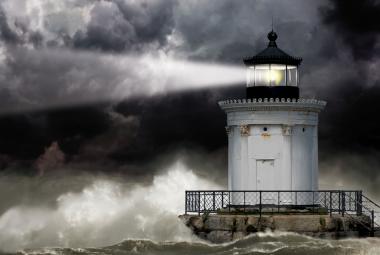And when he had opened the third seal, I heard the third beast say, Come and see. And I beheld, and lo a black horse; and he that sat on him had a pair of balances in his hand.
And I heard a voice in the midst of the four beasts say, A measure of wheat for a penny, and three measures of barley for a penny; and see thou hurt not the oil and the wine.
John tells us that the price of grain is one denarius — about ten times its normal price when these words were penned in the first century. At those prices, each worker would barely be able to feed one person — or require that the entire family try to survive on the amount of food that just one person needed to survive.
For those of us who live in the developed world, it’s hard for us to imagine being truly hungry; let alone standing by helplessly as our children or grandchildren go to bed with empty stomachs. Yet, we have witnessed soaring food prices and starvation often in modern times — both in the third world and also in developed nations. We saw it happen repeatedly early in the 20th Century:
- In 1921 Poland, food prices doubled every 19 days.
- In 1923 Germany, they doubled every four days.
- In 1944 Greece, they doubled every four days.
- In 1946 Hungary, food prices doubled every 15 hours.
We’ve also seen government-engineered famines more recently:
- In 1982 Mexico, the inflation rate hit 10,000%, driving the price of food up 100 times in 12 months.
- In 1989 Argentina, the Peso was devalued three times, driving food prices up 3,079% in a single year.
- In 1994 Brazil, inflation raged at 2,075.8% per year, making food more than 20 times more expensive.
- In 1994 Yugoslavia, food prices doubled every 34 hours.
- And in 2008 Zimbabwe, they doubled every single day.
Hyperinflation
The best-documented hyperinflationary episode in history is the one that nearly destroyed Germany between 1922 and 1923. The German government began printing unbacked paper marks – first, to finance World War I and later, to pay war reparations. By late 1923, 300 paper mills and 2,000 printing presses worked around the clock cranking out German banknotes.
The human toll was devastating: On average, prices doubled every three days. In a single month, prices exploded more than 32,000% higher — enough to drive prices up by a factor of 320 in a single, 30-day period.
My German grandparents sold their restaurant in order to retire. However, by the time formalities were completed, all they received was enough to buy a loaf of bread!
These crises were entirely man-made. Their nation’s leaders made them by creating unbacked paper marks out of thin air. So what does this have to do with you and me in today’s world? Quite simply, everything!
You see, Germany sank into the most severe hyperinflationary period in recorded history after printing 1.3 trillion marks. That translates to about 4 trillion in today’s dollars.
Ironically, that is almost exactly the same amount of money the United States government has printed since 2008.
But that’s only the tip of the iceberg because:
- The European Union has printed 503 billion euros — equal to about 627 billion dollars.
- Japan has printed 180 trillion yen, equal to about $1.5 trillion.
- The UK has printed 314 billion pounds, equal to about $493 billion. Altogether, that’s well over $6 trillion.
And despite the fact that most of that money is still being held on bank balance sheets and has yet to trickle into the economy, food prices are already beginning to rise rapidly.
Flour prices are up 19% … ice cream is up 21% … rice and cheddar cheese are both up 27% … chicken is up 34% … oranges are up 70% … and hamburger meat is up a whopping 74%.
And this is only the beginning. Because that trickle of newly printed money flowing into the economy will fast become a flood. As the rest of it hits food prices, they can only explode higher with no end in sight. Inflation Isn’t the Only Problem.
“Civilization and Anarchy are just seven meals apart”
— Spanish Proverb
The food problem is affected by many different factors even after you take into account inflation, war, unrest, disease and weather. Here are at least five major concerns not covered above that food producers and suppliers must also deal with:
- Limited arable land – land that has the needed nutrients and water to sustain crops.
- Crop yield ratios – crop yields seem to be plateauing or are increasing considerably slower than the population.
- Growing population – many experts expect the planet to add another 2 billion people in the next 35 years.
- Changing diets in emerging markets – developing countries are demanding more and better foods.
- Bio-fuel demand – crops to supply cheaper and cleaner fuels continue to take precedent over food crops.
Bayes’ Theorem
It can be useful to exploit a technique that goes by several names including “causal inference” or “inverse probability” — based on a mathematical equation called Bayes’ Theorem. Basically, you form a hypothesis based on experience, common sense and whatever data are available. Then you test the hypothesis not by what has happened before, but by what comes after.
Instead of reasoning from cause to effect, you reverse the process. You watch the effects to determine the cause. This will validate or invalidate the ‘cause’ which you have hypothesized. Sometimes, the effects contradict the hypothesis, in which case you can modify it or adopt another. Often, the effects confirm the hypothesis, in which case you know you’re on the right track and keep going.
The theorem has proved its worth, such as in 2012 when it was used to successfully predict the outcome of the U.S. presidential election in all 50 states before the final vote counts were available. Despite its success it has always been regarded with some suspicion by statisticians particularly because it has been used when genuine prior data is unavailable or uncertain.
Bad Debts
Prof. Laurence Kotlikoff,[1] (a widely accepted expert) using CBO figures estimates that the U.S. national indebtedness is $222 trillion at last count, and growing. That’s $17 trillion current, national debt, plus over $200 trillion unfunded liabilities for Social Security, Medicaid and other entitlement programs.
To put that in perspective, McKinsey Global Institute calculates that the total wealth of the world is estimated at $200 trillion. So, at $222 trillion, the US fiscal gap is 11% larger than all the accumulated wealth existing in the world today!
That’s almost $500,000 for every man, woman, and child. The U.S. government borrows four out of every ten dollars it spends.
One popular hypothesis is that the world is facing a tsunami of more than $2 trillion of bad debt just coming from oil drilling, emerging markets and corporate junk bonds. Even money-losing operations can keep up debt service for a while by using working capital and cash flow — at least until the cash runs out. Banks that hold some of the debt can also cover up the losses for a while with accounting games such as fiddling with their loan loss reserves. If so, bank stocks may take a major hit by early 2016 as these losses come home to roost.
Using the language of Bayes’ Theorem, bad debts will be the “cause” of a drop in financial stocks. What are the other “effects” to test the validity of these hypotheses?
For energy junk debt, we can look at rig counts in the oil patch and layoffs among energy exploration companies. For emerging-market debt, we can look at the strong dollar and dwindling hard currency reserves in countries like Russia, Turkey, Mexico and Brazil. In short, we can work backward from these visible causes to test the validity of the original hypothesis.
Right now, the idea that financial stocks will suffer major write-offs by this time next year looks like a good one.
If it were only so simple. Stocks may rise much higher before a crisis hits. If no fed rate increase this year comes true, it could be extremely bullish for U.S. equity markets. Right now, equity markets are priced for a rate hike in mid–2015. When markets realize that easy-money policies could continue into 2016, another upward thrust of the bull market would commence, and a level of 2,200 or higher on the S&P 500 index would not be surprising.
The Age of Deceit at Work
Not wanting to sound like a conspiracy theorist, but it seems almost no one has connected the dots between Yellen[2] and Draghi,[3] and most seem to assume that they each operate independently.
However, some suggest that the rapid rise of the dollar is being allowed because it is part of the “plan” to save the Eurozone and hold back the inevitable U.S. rate increases. The under-the-counter payoffs allow corporations to continue to buy back shares and increase dividends by borrowing at near-zero rates forever — clearly visible in the bank’s celebratory “stress test” announcements. Whether this game ends in a massive economic collapse or the establishment of Special Drawing Rights is not important, as either will result in the same outcome for the world’s 95% — economic disaster and enslavement.
This was also underlined with CNBC’s celebration of 500,000 newly minted American millionaires — establishing 5% of American households with assets greater than $1 million, (while CNBC failed to report that American families living in poverty have increased to 35%.)
Just in from the Agriculture Department: The number of Americans on food stamps has now topped 46 million every month since September 2011.
This does seem to speak of a real destruction of America’s moral political leadership.
One way to approach the “Age of Deceit” is to establish your own prior probabilities to trigger your own “tests.”
For a more detailed exploration of these ideas, see our briefing pack on the ostensible advent of the “Black Horseman.”
Notes:
- Laurence J. Kotlikoff is a William Fairfield Warren Professor at Boston University, a Professor of Economics at Boston University, a Fellow of the American Academy of Arts and Sciences, a Fellow of the Econometric Society, a Research Associate of the National Bureau of Economic Research, President of Economic Security Planning, Inc., and the Director of the Tax Analysis Center. Professor Kotlikoff received his B.A. in Economics from the University of Pennsylvania in 1973 and his Ph.D. in Economics from Harvard University in 1977. Kotlikoff attempted to run for President of the United States in the 2012 election, and sought the nominations of the advocacy group Americans Elect and the Reform Party of the United States before ending his campaign in May 2012. ↩
- Janet Yellen is the 15th Chair of the Federal Reserve. ↩
- Mario Draghi is an Italian economist, manager and banker who succeeded Jean-Claude Trichet as the President of the European Central Bank on 1 November 2011. He was previously the governor of the Bank of Italy from December 2005 until October 2011. In 2014 Forbes nominated Draghi as the 8th most powerful person in the world. ↩







